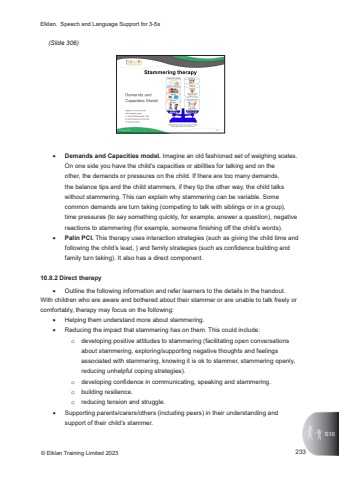Page 235 - Demo
P. 235
Elklan. Speech and Language Support for 3-5s%u00a9 Elklan Training Limited 2023 233S10(Slide 306)%u2022 Demands and Capacities model. Imagine an old fashioned set of weighing scales. On one side you have the child%u2019s capacities or abilities for talking and on theother, the demands or pressures on the child. If there are too many demands,the balance tips and the child stammers, if they tip the other way, the child talks without stammering. This can explain why stammering can be variable. Some common demands are turn taking (competing to talk with siblings or in a group), time pressures (to say something quickly, for example, answer a question), negative reactions to stammering (for example, someone finishing off the child%u2019s words).%u2022 Palin PCI. This therapy uses interaction strategies (such as giving the child time and following the child%u2019s lead, ) and family strategies (such as confidence building and family turn taking). It also has a direct component.10.8.2 Direct therapy %u2022 Outline the following information and refer learners to the details in the handout.With children who are aware and bothered about their stammer or are unable to talk freely or comfortably, therapy may focus on the following:%u2022 Helping them understand more about stammering.%u2022 Reducing the impact that stammering has on them. This could include:o developing positive attitudes to stammering (facilitating open conversations about stammering, exploring/supporting negative thoughts and feelings associated with stammering, knowing it is ok to stammer, stammering openly, reducing unhelpful coping strategies).o developing confidence in communicating, speaking and stammering.o building resilience.o reducing tension and struggle.%u2022 Supporting parents/carers/others (including peers) in their understanding and support of their child%u2019s stammer.


